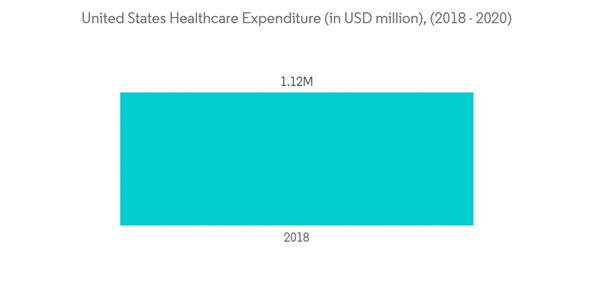The outbreak of the COVID-19 virus has had a predominant effect on the economics and business of major countries of the world. Because of the outbreak, there has been a rise in the significance of big data in the healthcare sector. The prescriptive and predictive analytics solutions have been used to create prediction models to assess the advent of following waves of COVID-19 infection spread in various countries of the world. The rise in the acceptance of electronic health records in developed and developing nations during the pandemic has further fueled the expansion of the market in 2020. For instance, in 2021 an article titled, 'Health Analytics on COVID-19 Data with Few-Shot Learning' reported that health analytics tools can lead to the discovery of useful information and knowledge about diseases such as the coronavirus disease 2019 (COVID-19) and related diseases. This knowledge helps users to get a better understanding of the disease, and thus take part in preventing, controlling, and/or combating the disease.
The factors that drive the North American healthcare analytics market are favorable healthcare policies, the emergence of big data in the healthcare industry, and technological advancements accelerating market growth. The favorable healthcare policies in the region are another region to drive the healthcare analytics market. For instance, in 2022 an article titled 'The Affordable Care Act After a Decade: Its Impact on the Labor Market and the Macro Economy' reported that maturing value-based payment models, more than a decade since the passage of the Affordable Care Act in the United States, continue to create openings for companies that reimagine care delivery with a focus on patient experience, health outcomes, and costs. Also, the pandemic has accelerated the use of digital tools that use big data and machine learning in every health sector, helping to make many operations more efficient and spur innovation. The result could be better health outcomes at a lower cost.
With the recent global pandemic of COVID-19, there need to be strategies to treat this health pandemic. For instance, in 2020 an article titled, 'Big data analytics as a tool for fighting pandemics: a systematic review of the literature' reported that the adoption of big data, as well as big data analytics techniques, have been addressed in this context with the possibility of predicting, mapping, tracking, monitoring, and raising awareness about these epidemics and pandemics. For the collection and analysis of data, the software NVivo 12 and VOSviewer were used. The content analysis sought to identify how big data and big data analytics can help fight epidemics and pandemics. The types and sources of data used in cases of previous epidemics and pandemics were identified, as well as techniques for treating these data. Thus, the use of such technologies is driving the market in the region.
Therefore, due to the above-mentioned factors, the market is expected to show significant growth over the forecast period. However, lack of skilled personnel, data integrity, security issues, and the cost and complexity of software may slow down the growth of the market.
North America Healthcare Analytics Market Trends
The Predictive Analytics Segment is Expected to Hold a Major Market Share in the North America Healthcare Analytics Market
Predictive analytics, along with machine learning, is rapidly becoming one of the most discussed topics in healthcare analytics. Predictive analytics has proven to be a significant asset in the medical decision-making process. Patients respond differently to all types of treatment, especially chronic diseases. Additionally, predictive analytics can be used to identify warning signs before conditions become severe. With the COVID-19 pandemic being at the forefront of healthcare, researchers are putting resources into developing predictive analytic methods for combating the virus. For instance, in January 2022, CureMD Healthcare, manufacturing SMART Cloud Health IT solutions, announced the launch of its Rapid Testing Platform for COVID-19 testing.Predictive analytics can combine data from multiple sources including hospital-based electronic medical records, fall detection pendants, and historical use of medical alert services to identify seniors who are at risk of emergency transport in the next 30 days. This allows healthcare providers to reach out to a senior person even before a fall or other medical complication occurs, preventing unnecessary hospital readmissions and reducing costs of transportation, acute care, and rehabilitation. Apart from these recent mergers, acquisitions and partnerships are also driving the market segment in the region. For instance, in June 2022, Oracle completed its acquisition of Cerner. Cerner and Oracle can transform healthcare delivery by providing medical professionals with better information enabling them to make better treatment decisions resulting in better patient outcomes.
Thus, due to the above-mentioned reasons, the segment is expected to show significant growth over the forecast period.
.
.North America Healthcare Analytics Industry Overview
The North American healthcare analytics market is moderately consolidated, with some major players controlling a major share of the market, along with the presence of several niche players such as 3M Company, Allscripts Healthcare Solutions, Cerner Corporation, Information Builders Inc., International Business Machines Corporation (IBM), Mckesson Corporation, Oracle Corporation, Philips Healthcare, Sas Institute Inc., and Scio Health Analytics.Additional Benefits:
- The market estimate (ME) sheet in Excel format
- 3 months of analyst support
This product will be delivered within 2 business days.
Table of Contents
Companies Mentioned (Partial List)
A selection of companies mentioned in this report includes, but is not limited to:
- 3M Company
- Allscripts Healthcare Solutions
- Cerner Corporation
- Information Builders Inc.
- International Business Machines Corporation (IBM)
- Mckesson Corporation
- Oracle Corporation
- Philips Healthcare
- Sas Institute Inc.
- Scio Health Analytics
Methodology

LOADING...










